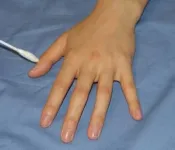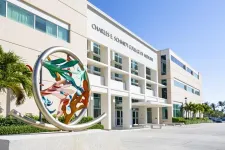SEATTLE, WASH.—December 3, 2024—The funding, provided through the Allen Distinguished Investigators, a program of The Paul G. Allen Frontiers Group at the Allen Institute, will fuel innovative research in Organelle Communication and Membrane Biophysics. Together these awards represent a total of $9 million dollars in funding from the Paul G. Allen Family Foundation, which will be distributed between 14 researchers investigating the biological principles governing fundamental cellular functions and how they interact. These foundational, cutting-edge research projects promise to advance the fields of biology and medicine.
“We are excited to have the Membrane Biophysics and Organelle Communication cohorts shed light onto two fundamental and interwoven aspects of cellular life – the dynamic functions of cell membranes and the complex interactions between organelles within the cell,” said Kathy Richmond, Ph.D., M.B.A., Executive Vice President and Director of the Frontiers Group and the Office of Science and Innovation at the Allen Institute. “These investigators will expand the frontiers of our basic science understanding of cell dynamics through ambitious and innovative approaches that span the tree of life, from single-celled amoebae to human cells, with important implications for human health.”
This research will drive vital scientific advancements in human biology.
“The six new projects are ambitious explorations into fundamental principles of cell and membrane biology with the potential to catalyze new frontiers of research and fuel vital discoveries,” said Rui Costa, Ph.D., D.V.M., President and CEO of the Allen Institute. “I’m excited to see the insights they surface and have little doubt that the drive, creativity, and commitment of the scientists involved will boldly advance our understanding of life, and that this new insight will benefit the global community.”
The Paul G. Allen Family Foundation will award $1.5 million to each of the six research projects which will involve pioneering researchers from around the world. These innovative projects, identified by The Paul G. Allen Frontiers Group, are early-stage research efforts that promise to have catalytic scientific potential.
2024 Allen Distinguished Investigators
Anđela Šarić, Ph.D., Institute of Science and Technology Austria (ISTA)
Kerstin Göpfrich, Ph.D., Heidelberg University
Buzz Baum, Ph.D., MRC Laboratory of Molecular Biology
Alba Diz-Muñoz, Ph.D., European Molecular Biology Laboratory (EMBL)
Carsten Schultz, Ph.D., Oregon Health & Science University
Amy Rowat, Ph.D., University of California Los Angeles
Douglas Robinson, Ph.D., Johns Hopkins University School of Medicine
Ileana M. Cristea, Ph.D., Princeton University
Jared Toettcher, Ph.D., Princeton University
Itay Budin, Ph.D., University of California San Diego
Christopher Obara, Ph.D., University of California San Diego
Sarah Cohen, Ph.D., University of North Carolina at Chapel Hill
Assaf Zaritsky, Ph.D., Ben-Gurion University of the Negev
Shalin Mehta, Ph.D., Chan Zuckerberg Biohub San Francisco
Meet the New Allen Distinguished Investigators Researching Membrane Biophysics
Researchers in this cohort will focus on cellular membranes that separate cell contents from the surrounding environment, allow cells to change shape, exchange materials, and respond to their environment. Despite having been implicated in numerous human diseases, little is known about the principles governing cell membrane biology and biophysics. This cohort will expand the frontiers of our understanding of fundamental aspects of cell membrane form, function, and dynamics using innovative technologies and analytical frameworks, with important implications for basic science and human health.
Mechanobiology tools for dissecting drivers of membrane mechanics, form, and function
Amy Rowat, Ph.D., University of California, Los Angeles
Douglas Robinson, Ph.D., Johns Hopkins University School of Medicine
In this project, the investigators will develop high-throughput screening technologies which use CRISPR-Cas9 to identify proteins that impact cell membrane mechanics, particularly how membranes adapt to physical stresses. They will test how these proteins affect membrane stability and resilience across the tree of life, from a single-celled amoeba to cultured human lung cells. Understanding cell membrane adaptability is a frontier in basic biology with implications for human health.
David and Goliath at the cell surface: Photo-crosslinkable lipid derivatives to control membrane mechanics
Alba Diz-Muñoz, Ph.D., European Molecular Biology, Laboratory (EMBL)
Carsten Schultz, Ph.D., Oregon Health & Science University
In this project, the researchers will pioneer a toolkit to change the lipid composition of the cell membrane by light, putting control of membrane biophysics into the hands of the researchers. They will use this technology to determine whether the cell membrane plays a stronger role in changes in cell shape, particularly cell division, than previously thought. The tools these investigators will develop will be broadly beneficial to a variety of basic and translational investigations, from developmental to cancer biology.
Chemically active membranes in the generation of cell shape
Anđela Šarić, Ph.D., Institute of Science and Technology Austria
Kerstin Göpfrich, Ph.D., Heidelberg University
Buzz Baum, Ph.D., MRC Laboratory of Molecular Biology
This project challenges the assumption that the cell membrane is a passive material, changing shape only when pushed or pulled. The researchers will use simulations, synthetic cells, and live archaeal cell communities to determine the chemical conditions that lead to the formation of tentacle-like protrusions cells use to explore their environment. This project will expand our knowledge of how cell membranes enable cells to interact dynamically with their environment in a broad ecological and evolutionary context.
Meet the New Allen Distinguished Investigators Researching Organelle Communication
These researchers will explore a thrilling frontier in cell biology emerging from the discovery that organelles (cellular compartments) can directly connect to each other to exchange materials and information, forming complex and dynamic networks. Much of how these interactions occur remains unknown due to the profound challenges of observing rapid events on a nanometer scale. This cohort will pioneer new tools to directly observe and model the organelle ‘interactome’ across time, space, and cell type. Their findings will expand our understanding of core biological principles, with powerful implications for fields ranging from regenerative medicine to virology.
Data-driven modeling of inter-organelle dynamic interactions throughout differentiation with multispectral and label-free live imaging
Sarah Cohen, Ph.D., University of North Carolina at Chapel Hill
Assaf Zaritsky, Ph.D., Ben-Gurion University of the Negev
Shalin Mehta, Ph.D., Chan Zuckerberg Biohub San Francisco
These investigators hypothesize that complex and dynamic patterns of organelle connection and communication are distinctive across different cell types, helping to drive the function and physiology of the cell. They will employ machine learning to identify key features of organelle-organelle interactions that affect cell trajectories during stem cell differentiation. They will then test the causal impact of these interactions by artificially tethering organelles together. This project will establish groundbreaking imaging and computational tools with implications for cell engineering.
Intra- and inter-cellular communication driven by membrane contact sites within a virus microenvironment
Ileana M. Cristea, Ph.D., Princeton University
Jared Toettcher, Ph.D. Princeton University
These investigators have shown that viruses can alter organelle connections in a host’s cells, forcing infected cells to prime their neighbors to become more susceptible to infection. In this project, they will determine the underlying causes and consequences of this virus-induced organelle network reorganization by developing novel tools to monitor and manipulate organelle connections in cells at varying distances from viral infection sites. The approaches they develop can be extended to a multitude of biological contexts and will expand our understanding of inter- and intra-cell interactions and immunity.
Measuring lipid fluxes at membrane contact sites using new chemogenetic proximity sensors
Itay Budin, Ph.D., University of California San Diego
Christopher Obara, Ph.D., University of California San Diego
In this project, the investigators will develop visualization and tracking approaches to directly observe the transfer of lipids between organelles in unprecedented detail. These observations will provide insights into the architecture of these complex lipid transfer events and their impacts on cell homeostasis and organelle membrane functions. The tools developed in this project to track the traffic of lipids throughout the cell will be of wide use to the cell biology community, with implications for human metabolic and neurogenerative disorders.
The Allen Distinguished Investigators program was launched in 2010 by the late philanthropist Paul G. Allen to back creative, early-stage research projects in biology and medical research that would not otherwise be supported by traditional research funding programs. Including the new awards, a total of 130 Allen Distinguished Investigators have been appointed during the past 12 years. Each award spans three years of research funding.
About The Paul G. Allen Frontiers Group
The Paul G. Allen Frontiers Group, a division of the Allen Institute, is dedicated to exploring the landscape of bioscience to identify and foster ideas that will change the world. The Frontiers Group recommends funding to the Paul G. Allen Family Foundation, which then invests through award mechanisms to accelerate our understanding of biology, including Allen Discovery Centers at partner institutions for leadership-driven, compass-guided research; and Allen Distinguished Investigators for frontier explorations with exceptional creativity and potential impact. The Paul G. Allen Frontiers Group was founded in 2016 by the late philanthropist and visionary Paul G. Allen. For more information, visit alleninstitute.org/division/frontiers-group/
About the Allen Institute
The Allen Institute is an independent, 501(c)(3) nonprofit research organization founded by philanthropist and visionary, the late Paul G. Allen. The Allen Institute is dedicated to answering some of the biggest questions in bioscience and accelerating research worldwide. The Institute is a recognized leader in large-scale research with a commitment to an open science model. Its research institutes and programs include the Allen Institute for Brain Science, launched in 2003; the Allen Institute for Cell Science, launched in 2014; the Allen Institute for Immunology, launched in 2018; and the Allen Institute for Neural Dynamics, launched in 2021. In 2016, the Allen Institute expanded its reach with the launch of The Paul G. Allen Frontiers Group, which identifies pioneers with new ideas to expand the boundaries of knowledge and make the world better. For more information, visit alleninstitute.org.
# # #
Media Contact
Liz Dueweke, Sr. Communications and Media Relations Specialist
206-225-0596 | liz.dueweke@alleninstitute.org
END









